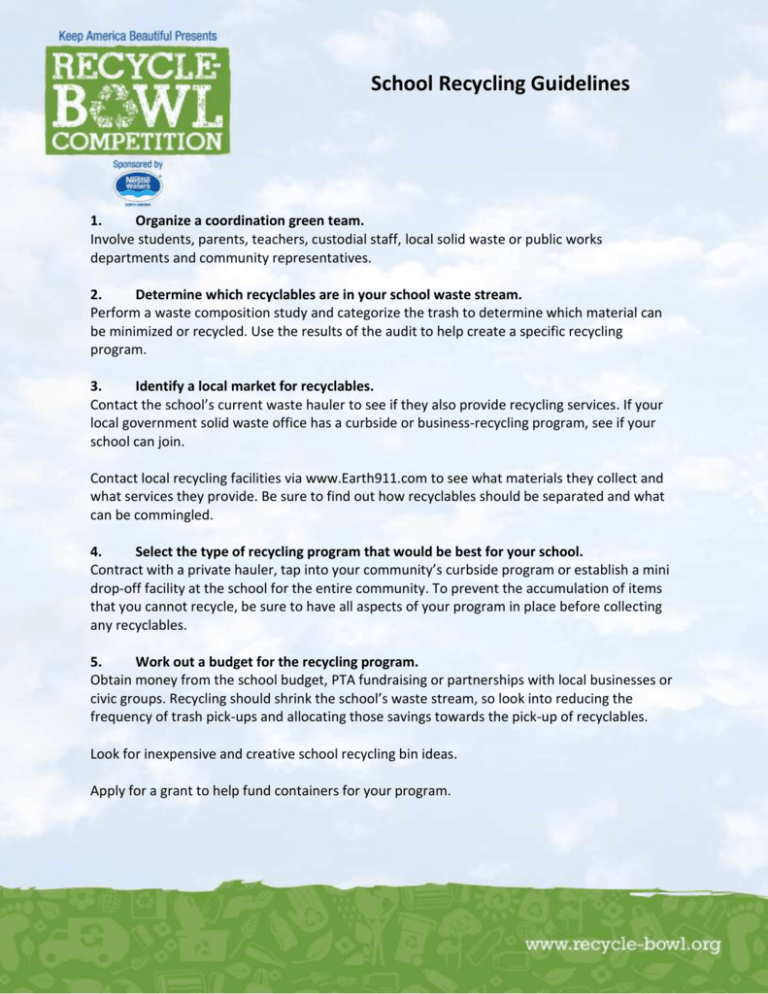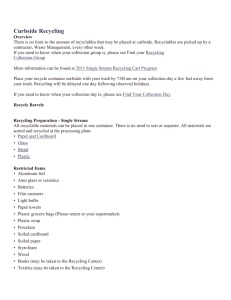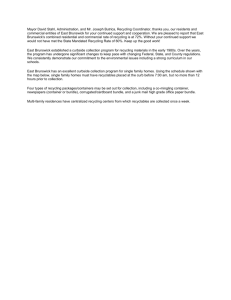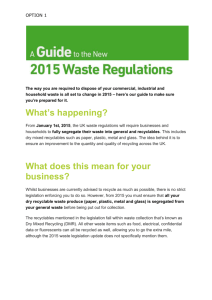Organize a coordination green team. Involve students, parents
advertisement

School Recycling Guidelines 1. Organize a coordination green team. Involve students, parents, teachers, custodial staff, local solid waste or public works departments and community representatives. 2. Determine which recyclables are in your school waste stream. Perform a waste composition study and categorize the trash to determine which material can be minimized or recycled. Use the results of the audit to help create a specific recycling program. 3. Identify a local market for recyclables. Contact the school’s current waste hauler to see if they also provide recycling services. If your local government solid waste office has a curbside or business-recycling program, see if your school can join. Contact local recycling facilities via www.Earth911.com to see what materials they collect and what services they provide. Be sure to find out how recyclables should be separated and what can be commingled. 4. Select the type of recycling program that would be best for your school. Contract with a private hauler, tap into your community’s curbside program or establish a mini drop-off facility at the school for the entire community. To prevent the accumulation of items that you cannot recycle, be sure to have all aspects of your program in place before collecting any recyclables. 5. Work out a budget for the recycling program. Obtain money from the school budget, PTA fundraising or partnerships with local businesses or civic groups. Recycling should shrink the school’s waste stream, so look into reducing the frequency of trash pick-ups and allocating those savings towards the pick-up of recyclables. Look for inexpensive and creative school recycling bin ideas. Apply for a grant to help fund containers for your program. 6. Establish a system for collecting and storing recyclables at your school. Make bins easily accessible. Focus on areas that generate recyclables, such as classrooms, the cafeteria, athletic fields, teacher lounges and copy rooms. Bins can be old copy paper boxes, plastic storage containers or a local government curbside recycling bin. Have students decorate bins with their own artwork. Check with the fire marshal for storage and collection requirements. If a private hauler will collect the recyclables, be sure to set aside storage space for the containers and allow truck access. Designate a publicly accessible area, if establishing a community drop-off facility. 7. Educate the school and the community about the program. Inform all school personnel, students, parents and the community about how the program will work. Let everyone know the collection procedures and what can and cannot be recycled. Monthly newsletters or e-mails can effectively inform the school community of the recycling program’s progress. Integrate environmental lesson plans and recycling education into the curriculum. 8. Set overall and individual recycling goals. Convey the goals of the recycling program to the school community and give specific examples of how each individual or class can help reach these goals. Tally recycling totals and track progress for all to see. Use these metrics to evaluate the program’s performance and set benchmarks for improvement. 9. Reward the doers. Let students know that a cleaner environment is a prize they can all enjoy. Give incentives to students and classes who participate.






